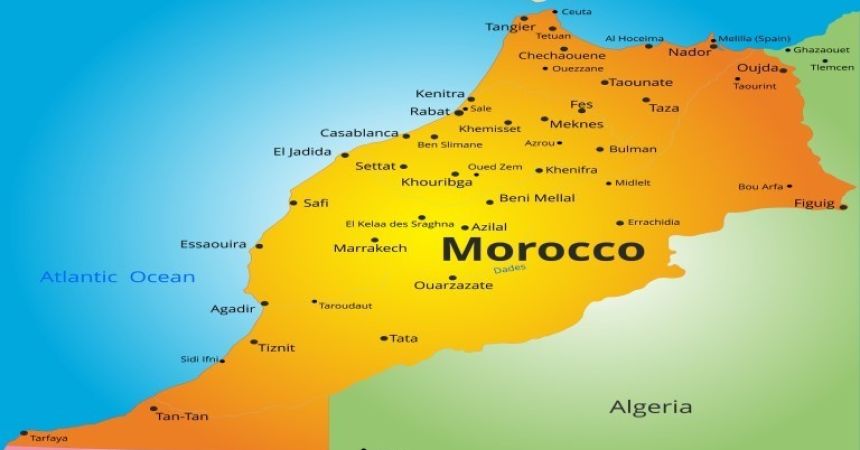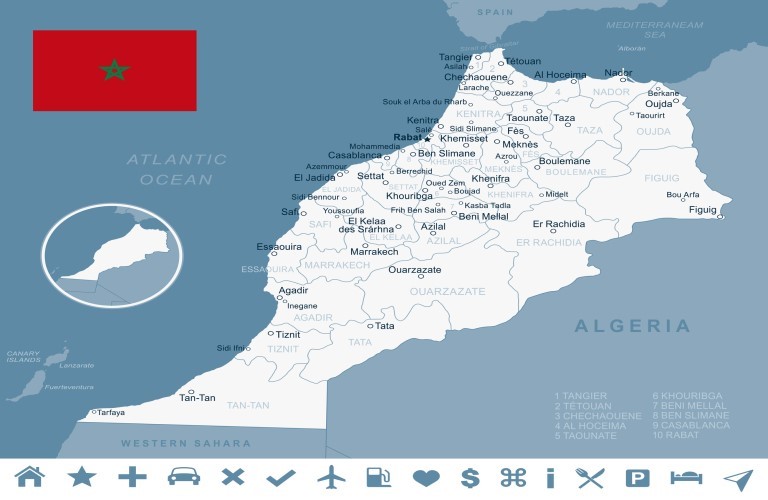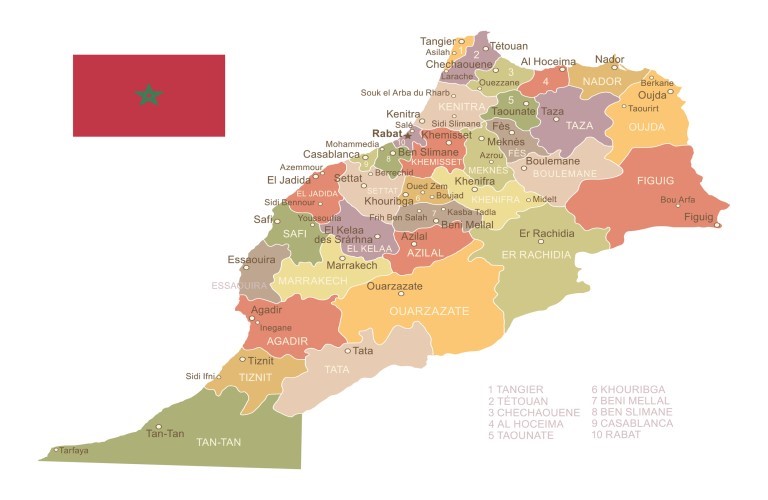
Morocco Map: Cities, Regions, and Attractions
Morocco, perched at the crossroads of Europe, Africa, and the Middle East, is a land of mesmerizing diversity. Its map is a visual testament to a country that boasts everything from expansive deserts and towering mountains to vibrant cities and Atlantic and Mediterranean coastlines. Each region has its own story, shaped by centuries of history and a blend of Berber, Arab, and European influences.
This blog takes you on a journey through Morocco, exploring its geographical features, major regions, and iconic destinations.
Geographical Overview of Morocco
Morocco spans approximately 446,550 square kilometers, excluding Western Sahara. Its strategic location in North Africa offers a unique blend of landscapes and climates. Morocco is bordered by:
Algeria to the east
Western Sahara to the south
Atlantic Ocean to the west
Mediterranean Sea to the north
The Strait of Gibraltar separates Morocco from Spain, making it the gateway to Europe.
Key Geographical Features of Morocco
-
Atlas Mountains
Stretching from the northeast to the southwest, the Atlas Mountains divide the country into distinct regions.
The range includes three main subranges: High Atlas, Middle Atlas, and Anti-Atlas.

-
Sahara Desert
The southeastern part of Morocco transitions into the vast Sahara Desert, featuring golden dunes like Erg Chebbi near Merzouga.
-
Coastlines
- Morocco enjoys a dual coastline:
- The Mediterranean coast is dotted with charming towns like Tangier and Tetouan.
- The Atlantic coast is home to cities like Casablanca, Rabat, and Essaouira.
-
Rivers and Valleys
- Rivers such as the Oum Er-Rbia and Moulouya sustain agriculture and lush valleys.
-
Plateaus and Plains
- The fertile plains, especially around Meknes and Fez, contribute to Morocco’s agricultural richness.
-
Administrative Regions of Morocco
Morocco is divided into 12 administrative regions, each with its unique charm and characteristics:
- Rabat-Salé-Kénitra
- Includes Rabat, the capital, known for its historical sites and diplomatic significance.
- Casablanca-Settat
- Home to Casablanca, the economic hub and Morocco’s largest city.
- Marrakech-Safi
- Known for Marrakech, the “Red City,” and Safi, famous for pottery and beaches.
- Fès-Meknès
- Hosts Fez, Morocco’s spiritual heart, and Meknes, a historical imperial city.
- Tanger-Tétouan-Al Hoceïma
- A northern region featuring Tangier, Tetouan, and the Rif Mountains.
- Souss-Massa
- Includes Agadir, a coastal city, and the Souss Valley.
- Drâa-Tafilalet
- Encompasses parts of the Sahara Desert and oases like Ouarzazate.
- Oriental
- A lesser-explored region bordering Algeria, with Oujda as the main city.
- Béni Mellal-Khénifra
- Known for its agricultural plains and the Middle Atlas.
- Guelmim-Oued Noun
- A gateway to the Sahara with towns like Guelmim.
- Laâyoune-Sakia El Hamra
- Located in the disputed Western Sahara, featuring the coastal city of Laâyoune.
- Dakhla-Oued Ed-Dahab
- Known for its remote beauty and kitesurfing spots.
Major Cities and Regions on the Map
-
Rabat
- The capital city blends history with modernity. Key attractions include:
- Hassan Tower
- The Royal Palace
- Kasbah of the Udayas
-
Casablanca
- A bustling metropolis known for:
- Hassan II Mosque
- Art Deco architecture
-
Fez
- Renowned for its well-preserved medina, Fez el Bali, a UNESCO World Heritage Site.
-
Marrakech
- The cultural heart of Morocco, offering:
- Jemaa el-Fnaa Square
- Majorelle Garden
- Koutoubia Mosque
-
Tangier
- A historic port city and gateway to Europe, known for:
- The Kasbah Museum
- Stunning Mediterranean views
-
Agadir
- A coastal resort town famous for its beaches and relaxed vibe.
-
Ouarzazate
- Known as the “Gateway to the Sahara,” it’s a hub for desert tours and film studios.
-
Chefchaouen
- The “Blue City” nestled in the Rif Mountains, known for its picturesque blue-painted streets.

Natural Wonders on Morocco’s Map
- Sahara Desert
- Erg Chebbi and Erg Chigaga dunes offer unforgettable desert experiences.
- High Atlas Mountains
- Home to Mount Toubkal, the highest peak in North Africa.
- Dades and Todra Gorges
- Stunning canyons with dramatic rock formations.
- Ouzoud Waterfalls
- One of Morocco’s most beautiful natural attractions.
- Agafay Desert
- A rocky desert close to Marrakech.
Traveling Across Morocco with Maps
- Road Trips
- Popular routes include:
- The drive from Marrakech to the Sahara Desert.
- The coastal journey from Casablanca to Essaouira.
- Cultural Routes
- Discover the imperial cities of Rabat, Fez, Meknes, and Marrakech.
- Hiking and Adventure
- Maps guide adventurers to trails in the Atlas Mountains and valleys.
- Desert Safaris
- Navigating routes to Merzouga or Zagora requires detailed maps.
Using Digital Maps in Morocco
Modern navigation tools like Google Maps and offline maps make it easy to explore urban areas and remote regions. Key features include:
- Turn-by-turn navigation.
- Offline access for areas with limited connectivity.
- Recommendations for local attractions and eateries.
Tips for Exploring Morocco Using Maps
- Plan by Region: Morocco’s regions offer distinct experiences; tailor your itinerary.
- Understand Terrain: Desert, mountains, and urban landscapes require different navigation strategies.
- Combine Digital and Traditional Maps: In rural areas, physical maps can be more reliable.
Discover Morocco: Best Holiday Destinations for Travelers
The map of Morocco is your guide to a country of contrasts and wonders. From the bustling souks of Marrakech to the serene dunes of the Sahara, every corner offers a new adventure. Whether you’re exploring ancient cities, hiking through mountains, or relaxing on sun-soaked beaches, the map of Morocco ensures that your journey is as seamless as it is unforgettable.



